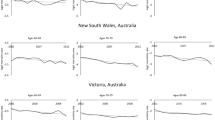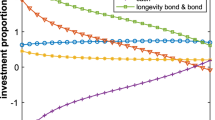Abstract
Pension plan sponsors and annuity providers can offload their longevity risk exposures by trading securities that are linked to broad-based mortality indexes. However, a hedge constructed in this way is subject to population basis risk, arising from the difference in mortality improvements between the hedger’s population and the reference population to which the security is linked. To address this problem, which is believed to be a major obstacle to market development, in this paper we contribute a graphical population basis risk metric. The graphical metric allows market participants to not only visually evaluate the extent of population basis risk, but also determine the most appropriate reference population. We illustrate this concept with a hypothetical example.


Similar content being viewed by others
Notes
Life and Longevity Markets Association (LLMA) (2012).
Stevens et al. (2011). The minimal required buffer refers to the minimum asset value (in excess of the best estimate value of the liabilities) such that the probability that the insurer or pension fund will be able to pay all future liabilities is sufficiently high.
Static hedging is more realistic, because dynamic hedging requires liquid longevity-linked securities that are not yet available in the current market for longevity risk transfers. See Fung et al. (2014).
As a matter of fact, the LLMA (www.llma.org) provides mortality indexes for these four national populations. Derivative securities can be written on LLMA's mortality indexes.
The approximation is exact if the force of mortality between two integer ages is constant.
See Gnanadesikan and Kettenring (1972) for further information about Mahalanobis distances.
References
Blake, D., Cairns, A., Coughlan, G., Dowd, K. and MacMinn, R. (2013) ‘The new life market’, The Journal of Risk and Insurance 80 (3): 501–557.
Blake, D., Dowd, K. and Cairns, A.J.G. (2008) ‘Longevity risk and the Grim Reaper’s toxic tail: The survivor fan charts’, Insurance: Mathematics and Economics 42 (3): 1062–1066.
Cairns, A.J.G., Dowd, K., Blake, D. and Coughlan, G.D. (2014) ‘Longevity hedge effectiveness: A decomposition’, Quantitative Finance 14 (2): 217–235.
Chan, W.S., Li, J.S.-H. and Li, J. (2014) ‘The CBD mortality indexes: Modeling and applications’, North American Actuarial Journal 18 (1): 38–58.
Continuous Mortality Investigation Bureau (2009) A prototype mortality projections model: Part two—detailed analysis, CMI working paper 39.
Cummins, J.D. and Trainar, P. (2009) ‘Securitization, insurance, and reinsurance’, The Journal of Risk and Insurance 76 (3): 463–492.
Dowd, K., Blake, D. and Cairns, A.J.G. (2010) ‘Facing up to uncertain life expectancy: The longevity fan charts’, Demography 47 (1): 67–78.
Dowd, K., Cairns, A.J.G., Blake, D., Coughlan, G.D. and Khalaf-Allah, M. (2011) ‘A gravity model of mortality rates for two related populations’, North American Actuarial Journal 15 (2): 334–356.
Fung, M.C., Ignatieva, K. and Sherris, M. (2014) ‘Systematic mortality risk: An analysis of guaranteed lifetime withdrawal benefits in variable annuities’, Insurance: Mathematics and Economics 58: 103–115.
Gnanadesikan, R. and Kettenring, J.R. (1972) ‘Robust estimates, residuals, and outlier detection with multiresponse data’, Biometrics 28 (1): 81–124.
Human Mortality Database, University of California, Berkeley USA; and Max Planck Institute for Demographic Research, Germany (2014) from www.mortality.org, accessed 1 March 2014.
International Monetary Fund (2012) Global Financial Stability Report: The Quest for Lasting stability, Washington, DC: International Monetary Fund.
Lee, R. and Mason, A. (2010) ‘Some macroeconomic aspects of global population aging’, Demography 47 (1 suppl): S151–S172.
Li, J.S.-H. and Hardy, M.R. (2011) ‘Measuring basis risk in longevity hedges’, North American Actuarial Journal 15 (2): 177–200.
Li, J.S.-H. and Luo, A. (2012) ‘Key q-duration: A framework for hedging longevity risk’, ASTIN Bulletin 42 (2): 413–452.
Li, N. and Lee, R. (2005) ‘Coherent mortality forecasts for a group of populations: An extension of the Lee-Carter method’, Demography 42 (3): 575–594.
LLMA (2012) ‘Basis risk in longevity hedging: parallels with the past’, Institutional Investors Journal 2012 (1): 39–45.
Ngai, A. and Sherris, M. (2011) ‘Longevity risk management for life and variable annuities: The effectiveness of static hedging using longevity bonds and derivatives’, Insurance: Mathematics and Economics 49 (1): 100–114.
Skirbekk, V. (2004) ‘Age and individual productivity: A literature survey’, in G. Feichtinger (ed.) Yearbook of Population Research, Vienna: Austrian Academy of Sciences Press, pp. 133–153.
Stevens, R., De Waegenaere, A. and Melenberg, B. (2011) ‘Longevity risk and natural hedge potential in portfolios of life insurance products: The effect of investment risk’, CentER Discussion Paper No. 2011-036.
van Groezen, B., Meijdam, L. and Verbon, H.A.A. (2005) ‘Serving the old: Ageing and economic growth’, Oxford Economic Papers 57 (4): 647–663.
Wallis, K.F. (2003) ‘Chi-squared tests of interval and density forecasts, and the Bank of England’s fan charts’, International Journal of Forecasting 19 (2): 165–175.
Acknowledgements
This work is supported by research grants from the Global Risk Institute, the Natural Science and Engineering Research Council of Canada, the Society of Actuaries Center of Actuarial Excellence Program, and the Research Grants Council of the Hong Kong Special Administrative Region (General Research Fund Project No. CUHK 440812H).
Author information
Authors and Affiliations
Rights and permissions
About this article
Cite this article
Chan, WS., Li, JH., Zhou, K. et al. Towards a Large and Liquid Longevity Market: A Graphical Population Basis Risk Metric. Geneva Pap Risk Insur Issues Pract 41, 118–127 (2016). https://doi.org/10.1057/gpp.2015.9
Received:
Accepted:
Published:
Issue Date:
DOI: https://doi.org/10.1057/gpp.2015.9




